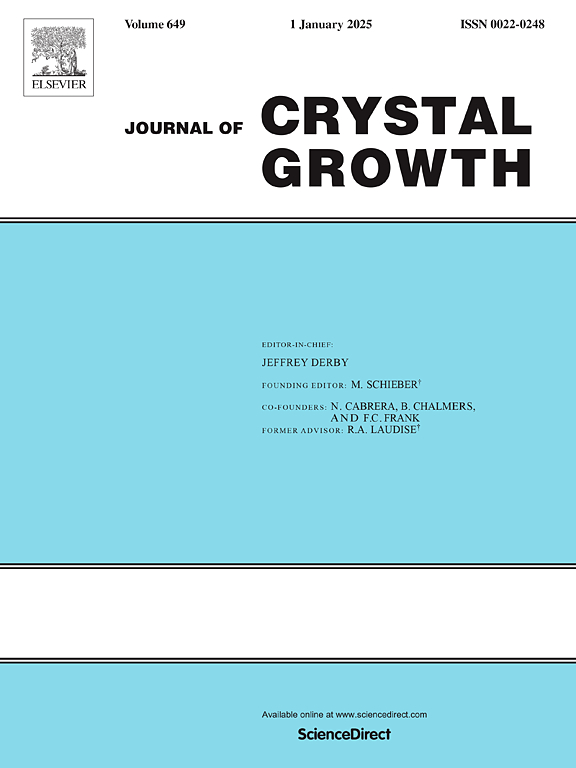Comparative analysis of machine learning approaches for predicting and interpreting Cz-sapphire growth
IF 1.7
4区 材料科学
Q3 CRYSTALLOGRAPHY
引用次数: 0
Abstract
This study evaluates four machine learning (ML) “white-box” methods − Decision Trees, Linear Regression, Python Symbolic Regression (PySR), and Sure Independence Screening and Sparsity Operation (SISSO) − and five “gray-box” methods − Gradient Boosting, XGBoost, Support Vector Machines (SVM), Gaussian Processes, and Random Forests − for analyzing data from the Cz-sapphire crystal growth process. The objective is to develop a model that achieves a balance between high predictive accuracy and interpretability in this small-data domain.
Twelve input variables − including process parameters, sapphire optical properties, and furnace geometry parameters − were analyzed in relation to five output variables: heating power, interface deflection, temperature gradients averaged at the solid/liquid interface and symmetry axis, and v/G. Using 500 data tuples from CFD simulations, the results highlighted significant performance differences across the models. SVM demonstrated superior performance in predicting temperature gradients, XGBoost excelled in interface deflection predictions, and Gradient Boosting was most effective for v/G. SISSO, known for its high interpretability, performed best in predicting heating power, particularly in cases where nonlinear noise was less pronounced.
The best performing models for each output generated explicit equations that relate inputs to outputs, feature importance plots, and 3D plots illustrating relationships within the 17-dimensional space. These findings offer theoretical insights for optimizing the Cz-sapphire crystal growth process and design.
预测和解释cz蓝宝石生长的机器学习方法的比较分析
本研究评估了四种机器学习(ML)“白盒”方法-决策树,线性回归,Python符号回归(PySR)和确定独立筛选和稀疏操作(SISSO) -以及五种“灰盒”方法-梯度增强,XGBoost,支持向量机(SVM),高斯过程和随机森林-用于分析cz蓝宝石晶体生长过程中的数据。目标是开发一个模型,在这个小数据领域实现高预测准确性和可解释性之间的平衡。研究人员分析了12个输入变量(包括工艺参数、蓝宝石光学特性和熔炉几何参数)与5个输出变量(加热功率、界面偏转、固/液界面和对称轴处的平均温度梯度以及v/G)的关系。使用来自CFD模拟的500个数据元组,结果突出了不同模型之间的显著性能差异。支持向量机在预测温度梯度方面表现优异,XGBoost在预测界面偏转方面表现优异,梯度boost在v/G预测方面最有效。SISSO以其高可解释性而闻名,在预测加热功率方面表现最佳,特别是在非线性噪声不太明显的情况下。对于每个输出,表现最好的模型生成了显式方程,这些方程将输入与输出、特征重要性图和说明17维空间内关系的3D图联系起来。这些发现为优化cz -蓝宝石晶体生长工艺和设计提供了理论见解。
本文章由计算机程序翻译,如有差异,请以英文原文为准。
求助全文
约1分钟内获得全文
求助全文
来源期刊

Journal of Crystal Growth
化学-晶体学
CiteScore
3.60
自引率
11.10%
发文量
373
审稿时长
65 days
期刊介绍:
The journal offers a common reference and publication source for workers engaged in research on the experimental and theoretical aspects of crystal growth and its applications, e.g. in devices. Experimental and theoretical contributions are published in the following fields: theory of nucleation and growth, molecular kinetics and transport phenomena, crystallization in viscous media such as polymers and glasses; crystal growth of metals, minerals, semiconductors, superconductors, magnetics, inorganic, organic and biological substances in bulk or as thin films; molecular beam epitaxy, chemical vapor deposition, growth of III-V and II-VI and other semiconductors; characterization of single crystals by physical and chemical methods; apparatus, instrumentation and techniques for crystal growth, and purification methods; multilayer heterostructures and their characterisation with an emphasis on crystal growth and epitaxial aspects of electronic materials. A special feature of the journal is the periodic inclusion of proceedings of symposia and conferences on relevant aspects of crystal growth.
 求助内容:
求助内容: 应助结果提醒方式:
应助结果提醒方式:


